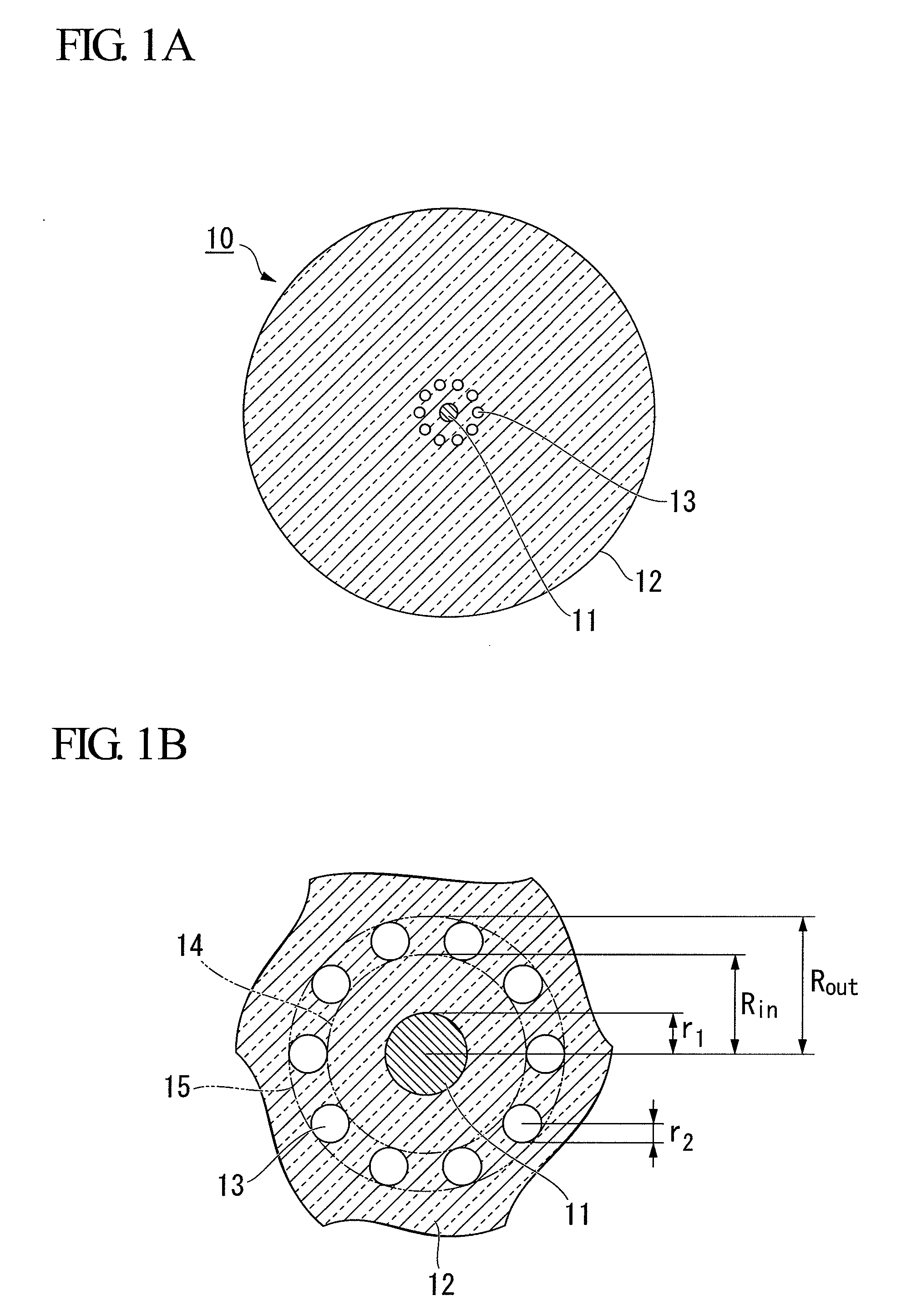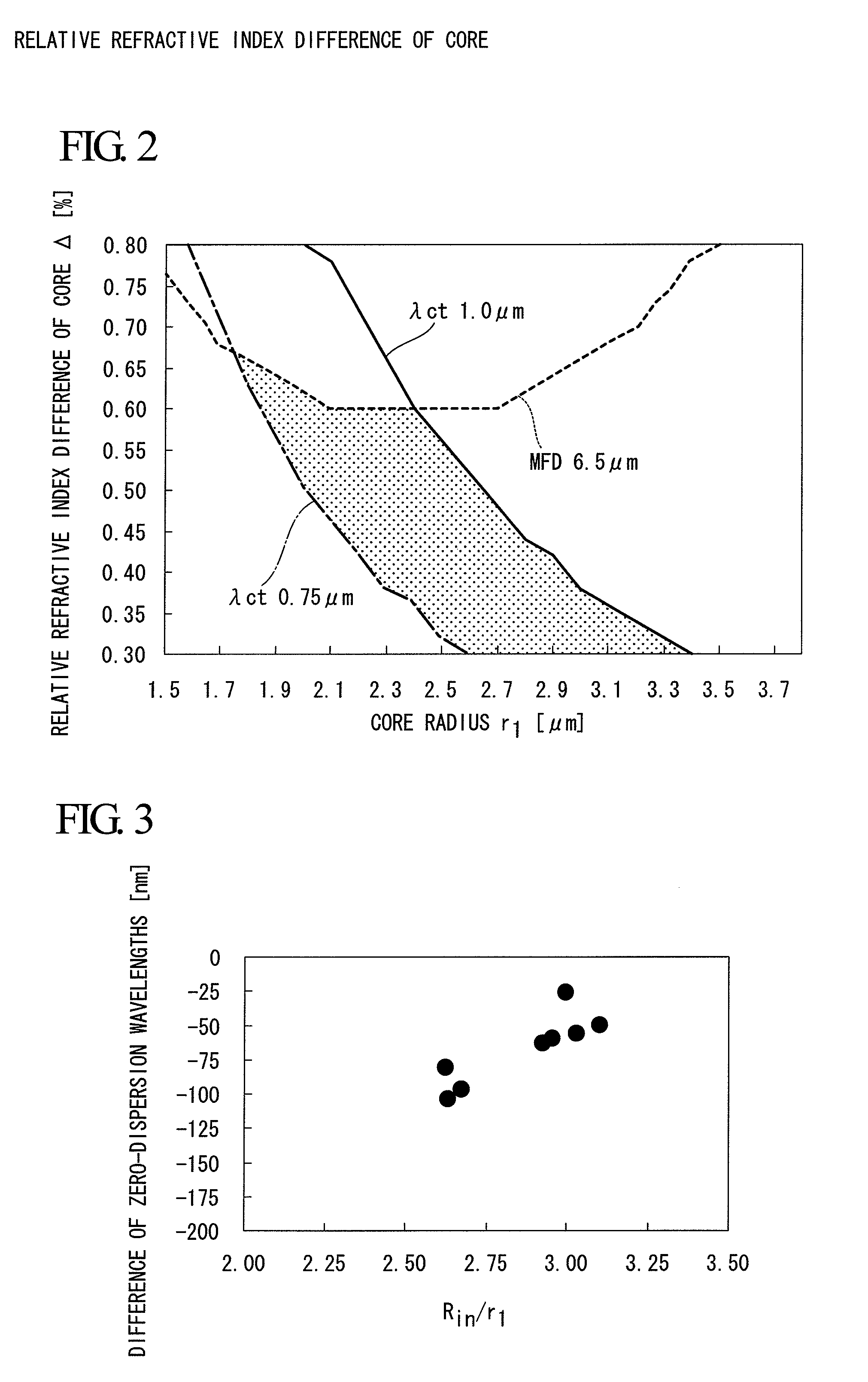Holey single-mode optical fiber and optical transmission system using same
a single-mode optical fiber and optical transmission system technology, applied in the direction of optical waveguide light guide, optical light guide, instrument, etc., can solve the problems of difficult manufacturing and expensive, large loss of transmission, and absence of waveguide structure locally, so as to facilitate the manufacture of optical fiber and low cost
- Summary
- Abstract
- Description
- Claims
- Application Information
AI Technical Summary
Benefits of technology
Problems solved by technology
Method used
Image
Examples
examples
[0095]As described below, an HAF is actually manufactured with respect to a case where a refraction index of the clad 12 is set to a pure silica level, a refraction index of the holes 13 is set to 1 (air), the core 11 is made of a silica glass of which the refraction index is increased by using germanium (Ge) as a dopant material, and a step-type refraction index distribution is shown, and the relationship between structure parameters and optical characteristics is obtained.
[0096]A cable cut-off wavelength represents a value measured by a measurement standard of an optical fiber, that is, a 7.6.1 Cable cut-off method of IEC 60793-1-44. In addition, in a case where the number of holes is varied, a correlation of each of the optical characteristics increases when using an air-filling fraction F rather than when using a hole diameter, such that the air-filling fraction F shown in the above-described equation (1) is used.
[0097]Structure parameters and main optical characteristics of eac...
first example
A First Example
[0098]In a first example, a holey single-mode optical fiber having 10 holes 13 around a core 11 as shown in FIG. 1A was manufactured. In a cross section of the optical fiber, the holes 13 are disposed in a single concentric circle.
[0099]Parameters such as a core radius and a core Δ are shown in fibers A to E of Table 1. The fiber E is an optical fiber manufactured for comparison, in which a core diameter and a core Δ are the same and thereby holes are not present. In Table 1, both a zero-dispersion and a cable cut-off wavelength are shown.
[0100]As can be seen from the result, when the air-filling fraction F is 50% or less, it satisfies the cable cut-off wavelength of 1.0 μm or less. In addition, the air-filling fraction F of 50.1% in the fiber C becomes 50% in two significant digits and satisfies the above-described “air-filling fraction is 50% or less”. On the other hand, as shown in the result of the fiber E, when the air-filling fraction F is 54.1%, that is, when i...
second example
A Second Example
[0112]As a second example, an HAF was manufactured with a parameter shown in fibers F to I of Table 1. The fiber I is an optical fiber manufactured for comparison, in which a core diameter and a core Δ are the same and holes are not present.
[0113]From Table 1, it can be seen that a cable cut-off wavelength is 1.0 μm or less and a zero-dispersion wavelength is between 1260 and 1460 nm, and thereby the requirement was satisfied. Measurement results of an MFD and a bending loss of each of the fibers is shown in Tables 5 and 6.
TABLE 5MFD [μm] of each fiberMeasurement wavelength[μm]1.061.241.311.481.551.625Fiber F7.18.18.49.39.79.9Fiber G7.18.08.49.29.59.7Fiber H7.18.08.49.29.59.5Fiber I7.18.38.710.010.711.4
TABLE 6Bending loss [dB / m] at a bending radius r of 10 mm of each fiberMeasurement wavelength [μm]1.551.625Fiber F26.837.4Fiber G6.56.8Fiber H1.64.7Fiber I>100>100
[0114]As shown in Table 5, a mode field diameter of a wavelength of 1.31 μm was a large value such as 8.4 ...
PUM
 Login to View More
Login to View More Abstract
Description
Claims
Application Information
 Login to View More
Login to View More - R&D
- Intellectual Property
- Life Sciences
- Materials
- Tech Scout
- Unparalleled Data Quality
- Higher Quality Content
- 60% Fewer Hallucinations
Browse by: Latest US Patents, China's latest patents, Technical Efficacy Thesaurus, Application Domain, Technology Topic, Popular Technical Reports.
© 2025 PatSnap. All rights reserved.Legal|Privacy policy|Modern Slavery Act Transparency Statement|Sitemap|About US| Contact US: help@patsnap.com



